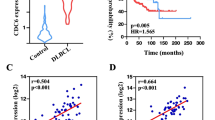Abstract
Deleted in liver cancer-1(DLC-1) gene expression is frequently down-regulated or deleted in many types of human cancer. To evaluate whether DLC-1 could be a therapeutic target for non-Hodgkin lymphoma (NHL), we examined the expressions of DLC-1 in Burkitt’s lymphoma (BL) cell lines and tested the effects of DLC-1 on cellular growth and migration in BL cells. DLC-1 expression was not detectable in two human BL cell lines, Raji and Daudi, by reverse transcription-PCR. The transfer of DLC-1 into Raji and Daudi cell lines caused a significant inhibition in cell proliferation. This inhibitory effect on cell proliferation in BL cell lines was accompanied by induction of apoptosis. Furthermore, restoration of DLC-1 expression in BL cells had a significant inhibitory effect on migration. Our findings suggest that DLC-1 may play an important role in lymphoma by acting as a bona fide new tumor suppressor gene.





Similar content being viewed by others
References
Yuan BZ, Miller MJ, Keck CL et al (1998) Cloning, characterization, and chromosomal localization of a gene frequently deleted in human liver cancer (DLC-1) homologous to rat RhoGAP. Cancer Res 58:2196–2199
Kim TY, Lee JW, Kim HP et al (2007) DLC-1, a GTPase-activating protein for Rho, is associated with cell proliferation, morphology, and migration in human hepatocellular carcinoma. Biochem Biophys Res Commun 355:72–77
Clark EA, King WG, Brugge JS et al (1998) Integrin-mediated signals regulated by members of the rho family of GTPases. J Cell Biol 142:573–586
Sekimata M, Kabuyama Y, Emori Y et al (1999) Morphological changes and detachment of adherent cells induced by p122, a GTPase-activating protein for Rho. J Biol Chem 274:17757–17762
Guan M, Zhou X, Soulitzis N et al (2006) Aberrant methylation and deacetylation of deleted in liver cancer-1 gene in prostate cancer: potential clinical applications. Clin Cancer Res 12:1412–1419
Yuan BZ, Durkin ME, Popescu NC (2003) Promoter hypermethylation of DLC-1, a candidate tumor suppressor gene, in several common human cancers. Cancer Genet Cytogenet 140:113–117
Ullmannova V, Popescu NC (2007) Inhibition of cell proliferation, induction of apoptosis, reactivation of DLC1, and modulation of other gene expression by dietary flavone in breast cancer cell lines. Cancer Detect Prev 31:110–118
Ullmannova V, Popescu NC (2006) Expression profile of the tumor suppressor genes DLC-1 and DLC-2 in solid tumors. Int J Oncol 29:127–1132
Yuan BZ, Jefferson AM, Baldwin KT et al (2004) DLC-1 operates as a tumor suppressor gene in human non-small cell lung carcinomas. Oncogene 23:405–1411
Zhang T, Zheng JC, Jiang N et al (2009) Overexpression of DLC-1 induces cell apoptosis and proliferation inhibition in the renal cell carcinoma. Cancer Lett 283:59–67
Herman JG, Baylin SB (2003) Gene silencing in cancer in association with promoter hypermethylation. N Engl J Med 349:2042–2054
Ng IO, Liang ZD, Cao L et al (2000) DLC-1 is deleted in primary hepatocellular carcinoma and exerts inhibitory effects on the proliferation of hepatoma cell lines with deleted DLC-1. Cancer Res 60:6581–6584
Janiak M, Hashmi HR, Janowska-Wieczorek A (1994) Use of the Matrigel-based assay to measure the invasiveness of leukemic cells. Exp Hematol 22:559–564
Durkin ME, Avner MR, Huh CG et al (2005) DLC-1, a Rho GTPase-activating protein with tumor suppressor function, is essential for embryonic development. FEBS Lett 579:1191–1196
Pineau P, Nagai H, Prigen S et al (1999) Identification of three distinct regions of allelic deletions on the short arm of chromosome 8 in hepatocellular carcinoma. Oncogene 18:3127–3134
Taylor KH, Pena-Hernandez KE, Davis JW et al (2007) Large-scale CpG methylation analysis identifies novel candidate genes and reveals methylation hotspots in acute lymphoblastic leukemia. Cancer Res 67:2617–2625
Shi H, Guo J, Duff DJ et al (2007) Discovery of novel epigenetic markers in non-Hodgkin’s lymphoma. Carcinogenesis 28:60–70
Hu Y, Lehrach H, Janitz M (2009) Apoptosis screening of human chromosome 21 proteins reveals novel cell death regulators. Mol Biol Rep [Epub ahead of print]
Qiong Z, Ruofan H, Xiaohua L, et al. (2009) Role of dephosphorylation of FOXO1 on apoptosis induced by wortmannin for non-Hodgkin’s lymphoma cells. Mol Biol Rep [Epub ahead of print]
Zhang L, Huang H, Wu K, et al. (2009) Impact of BTG2 expression on proliferation and invasion of gastric cancer cells in vitro. Mol Biol Rep [Epub ahead of print]
Zhu J, Zhang L, Jin X, et al. (2009) beta-Ionone-induced apoptosis in human osteosarcoma (U2os) cells occurs via a p53-dependent signaling pathway. Mol Biol Rep [Epub ahead of print]
Zhao H, Guo W, Peng C, et al. (2009) Arsenic trioxide inhibits the growth of Adriamycin resistant osteosarcoma cells through inducing apoptosis. Mol Biol Rep [Epub ahead of print]
Zhou X, Thorgeirsson SS, Popescu NC (2004) Restoration of DLC-1 gene expression induces apoptosis and inhibits both cell growth and tumorigenicity in human hepatocellular carcinoma cells. Oncogene 23:1308–1313
Goodison S, Yuan J, Sloan D et al (2005) The RhoGAP protein DLC-1 functions as a metastasis suppressor in breast cancer cells. Cancer Res 65:6042–6053
Jin Y, Tian X, Shang Y, Huang P (2008) Inhibition of DLC-1 gene expression by RNA interference in the colon cancer LoVo cell line. Oncol Rep 19:669–674
Holeiter G, Heering J, Erlmann P et al (2008) Deleted in liver cancer 1 controls cell migration through a Dia1-dependent signaling pathway. Cancer Res 68:8743–8751
Liao YC, Si L, Devere White RW et al (2007) The phosphotyrosine-independent interaction of DLC-1 and the SH2 domain of cten regulates focal adhesion localization and growth suppression activity of DLC-1. J Cell Biol 176:43–49
Acknowledgments
We thank Dr. Ronggui Hu and Dr. Zhaoyun Zhang for critical reading and editing of the manuscript. The study was supported by the Science Foundation of Education Bureau of Zhejiang Province (Grant No. Y200804608) and the grant of Shanghai Municipal Health Bureau (Grant No. 2010079).
Author information
Authors and Affiliations
Corresponding author
Additional information
Minhua Feng and Bo Huang contributed equally to this study.
Rights and permissions
About this article
Cite this article
Feng, M., Huang, B., Du, Z. et al. DLC-1 as a modulator of proliferation, apoptosis and migration in Burkitt’s lymphoma cells. Mol Biol Rep 38, 1915–1920 (2011). https://doi.org/10.1007/s11033-010-0311-z
Received:
Accepted:
Published:
Issue Date:
DOI: https://doi.org/10.1007/s11033-010-0311-z




